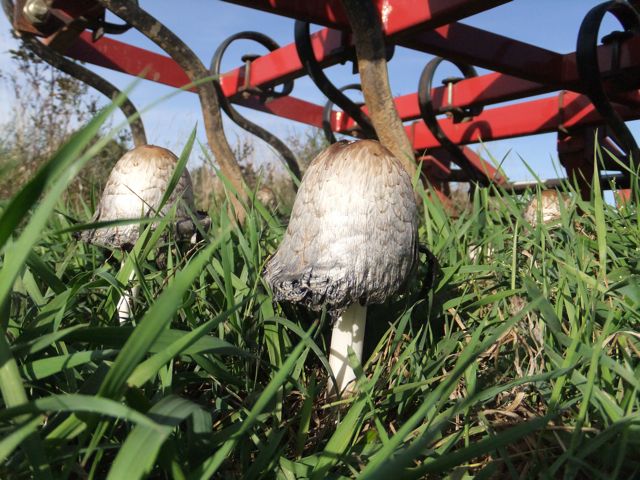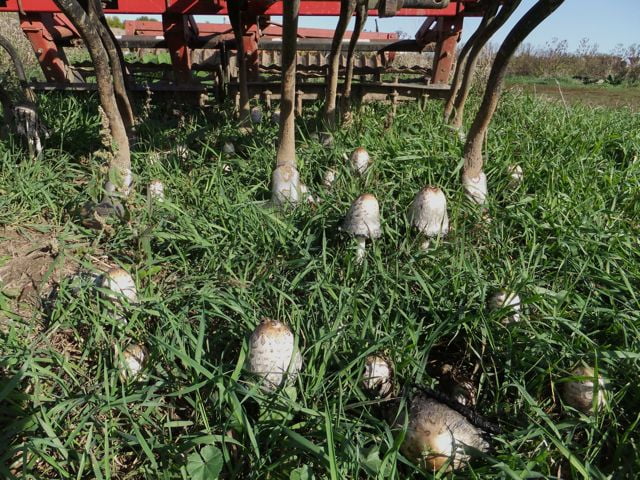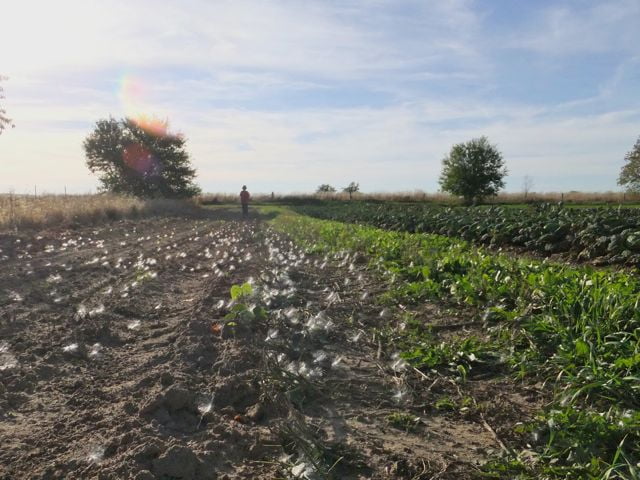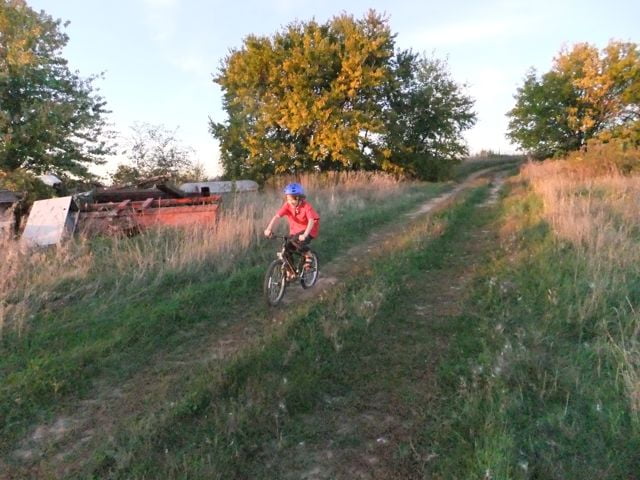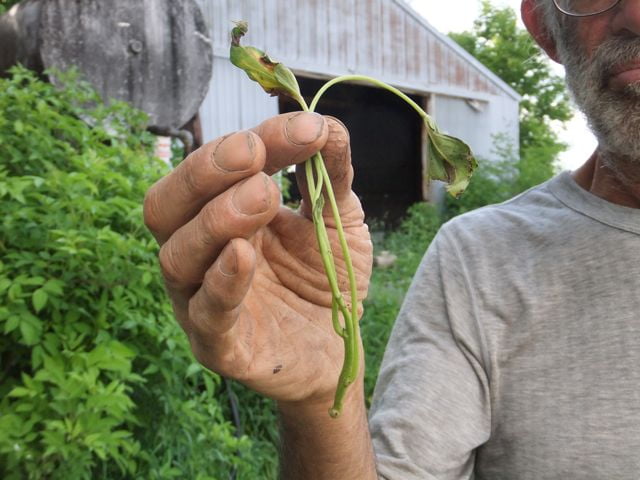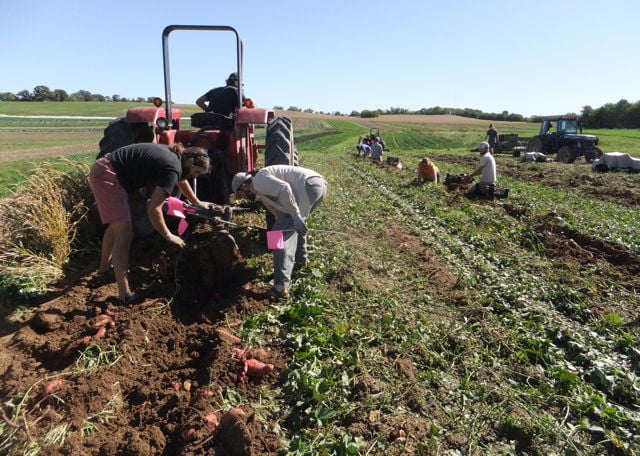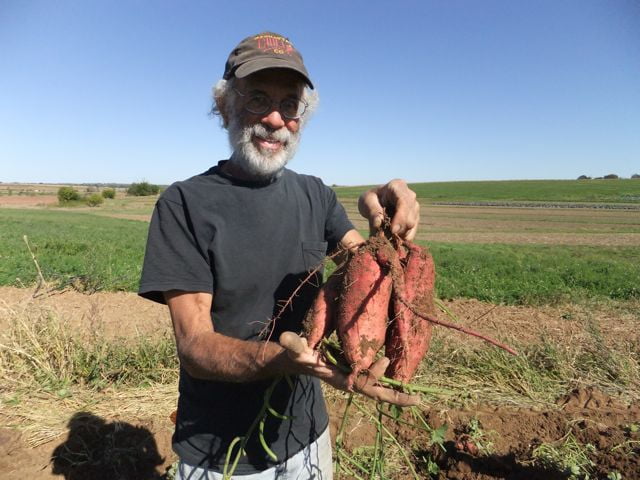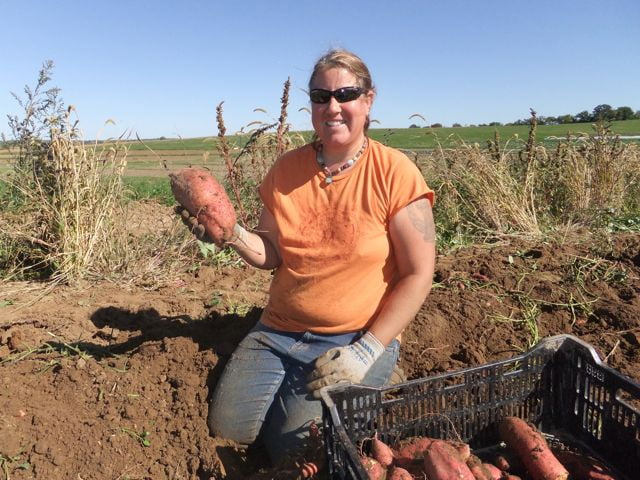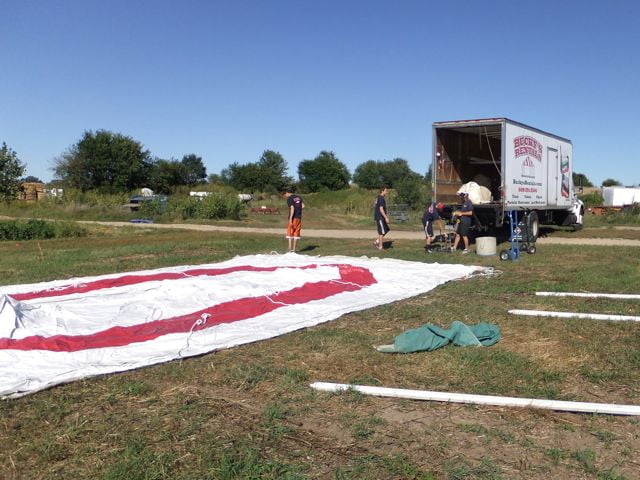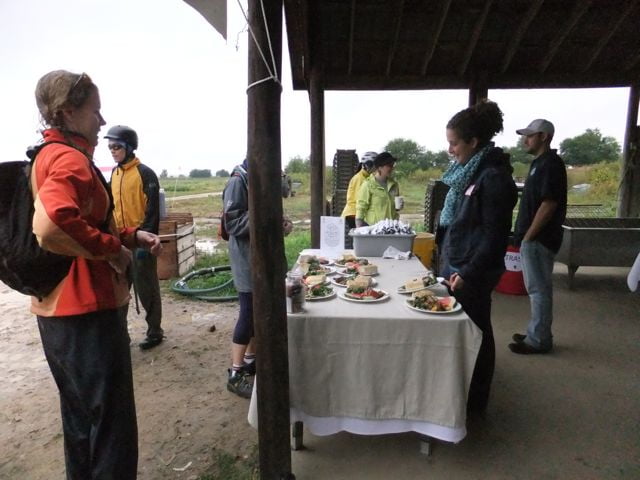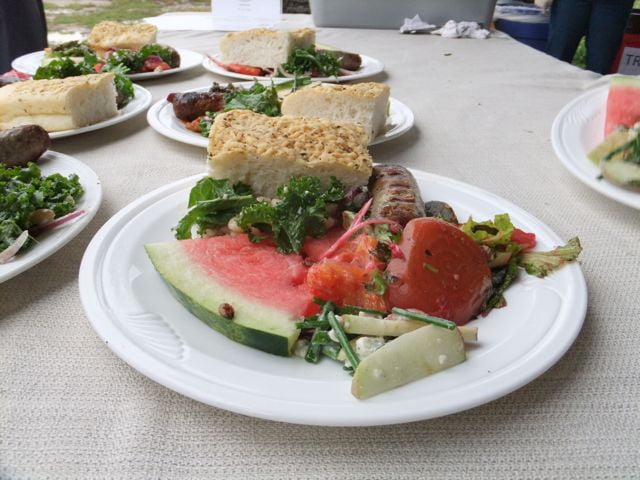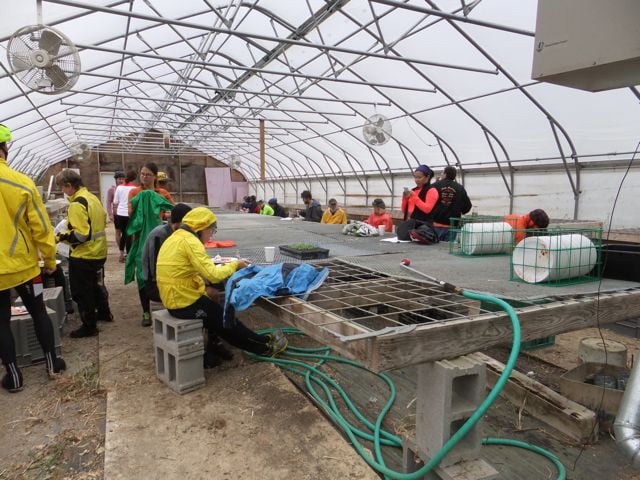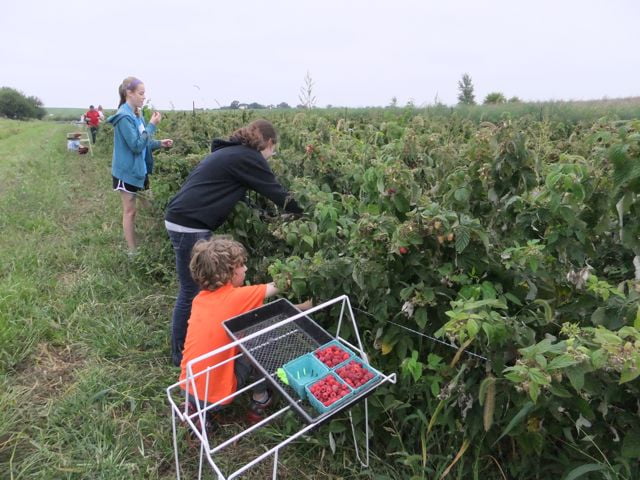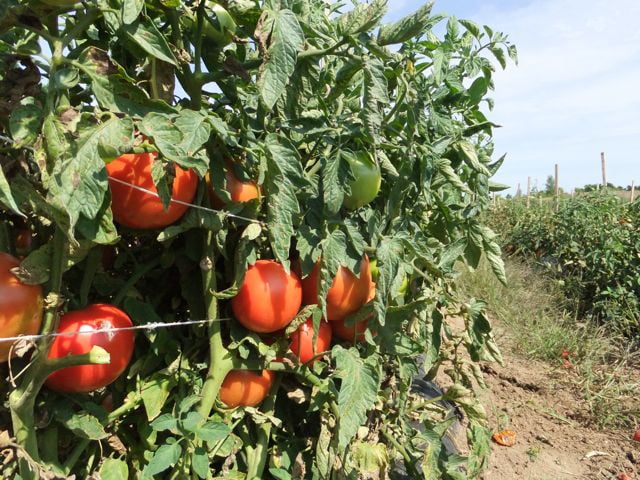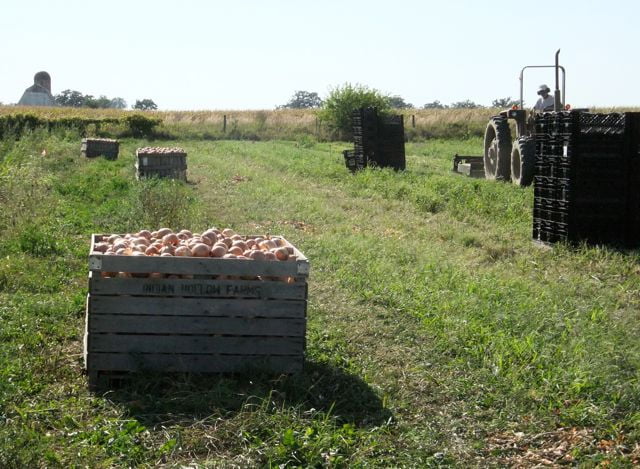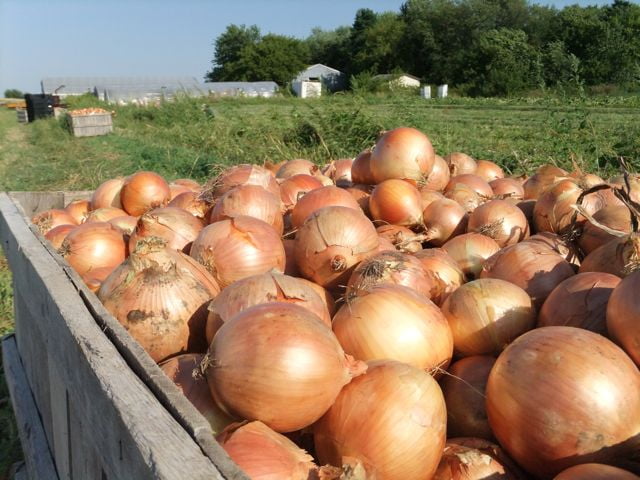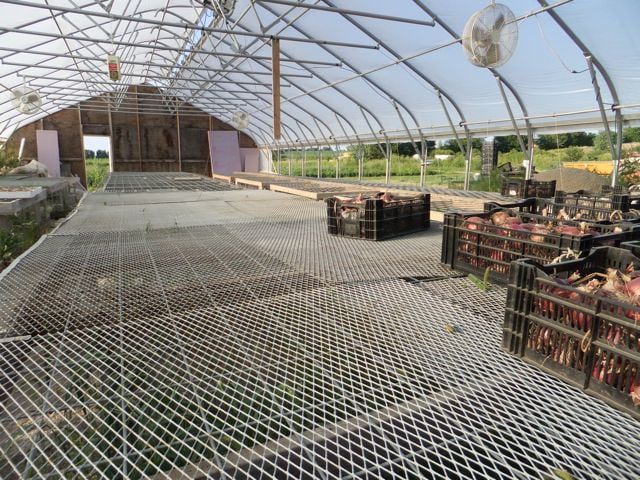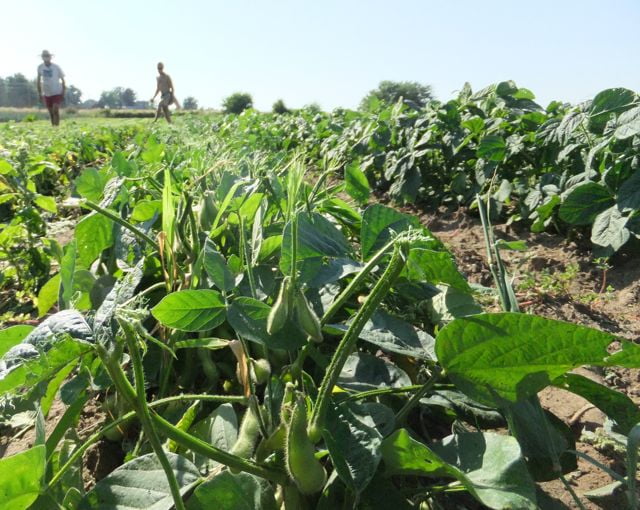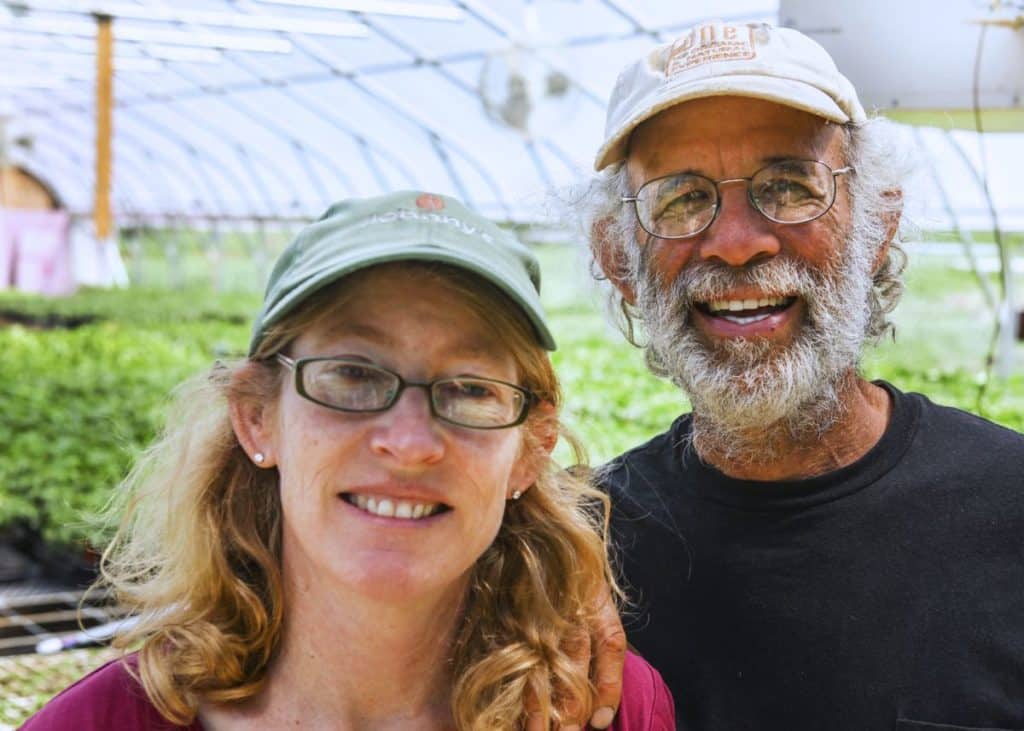Blog
Hooky
- On: October 09, 2013
 0
0
I took the afternoon off to wander the farm with our son and visit his favorite spots.
Beautiful inky cap mushrooms sprouted since Steve parked this implement. They’ll be gone before he needs it again.
We marveled at drifts of milkweed floss.
Our steepest hill is a blur. Soak up some warmth this week if you can. It won’t last much longer.
We are running low on CSA boxes.
Please return all your empty boxes. Remember, we ask that you leave the empty CSA boxes at your site this year. Take your produce home in your own bags or the plastic bags we provide. Outpost members, it’s too disruptive to do this in the stores. Just take the CSA box home and return it at your next delivery.
Local Thyme review
I’d like to remind everyone that we subscribe to Pat and Laura’s ‘Local Thyme’ menu service for recipes customized to use all of your CSA veggies. We must decide soon whether to buy the service again next year, and will survey your thoughts in a week or two. If you haven’t used the menus yet, give them a try. I’ll send the instructions again in this week’s email.
Veggie List and Veggie Notes.
Sweet Dumpling winter squash, 2
Green tomatoes, 1.8 lb
Carrots, 2 lb
Celeriac, 1
Tatsoi, 1 head
Onions, 2
Colored bell peppers, 2
Broccoli OR Romanesco broccoli
Scallions, 1 bunch
Next week’s box will probably contain winter squash, potatoes, Yukina greens, scallions and more.
Sweet Dumpling winter squash (round, speckled green and white or yellow) – This is one of our most flavorful winter squashes and a personal favorite. They are thinned-wall and sweet. Like the delicata we sent a few weeks ago, these have a central cavity that can be stuffed. This is another ‘short season’ winter squash, i.e. a type that does not store well. Eat soon.
Green tomatoes – We like to include green tomatoes in the CSA boxes for their sour/tangy/citrusy flavor, a note that is generally missing from our boxes. Some will be fully green, some will have a red blush. It is the end of the tomato season, so some of the green tomatoes have small flaws that need trimming. Store in the refrigerator.
Our farm cooks have a few favorite ways to prepare green tomatoes.
– Fried green tomatoes. This is the classic way to prep green tomatoes.
– If you prefer to avoid frying, try slicing the tomatoes, dredging in seasoned bread crumbs, then baking on an oiled cookie sheet until softened.
– Use as a substitute for tomatillos.
– Beth’s favorite: Prepare your usual tomato sauce, but substitute chopped green tomatoes for red. Add a little water to the pot to start the cooking process, as it takes longer for green tomatoes to soften. Excellent as a chutney or as pizza sauce.
– Add thin slices to casseroles.
I tried the last suggestion. I added thinly sliced raw green tomatoes while preparing lasagna, then baked the lasagna for one hour (I use the raw-noodle approach that requires long cooking). The green tomatoes were a great addition. They softened but kept their shape and tang. I also added sliced red peppers and minced greens to the lasagna. All were nicely cooked by the end of an hour.
Celeriac (knobby, round, bizarre-looking vegetable which smells like celery) – Flavorful celeriac is good raw or cooked. It is excellent in mixed roasted veggies or in soup. It’s especially good in cream soups, alone or mixed with potatoes. Grated raw celeriac is a great starting point for winter salads. Celeriac will store in your refrigerator for months. Cut off chunks as you need them. Peel before using.
Tatsoi (large rosette of dark green leaves) – This green is related to bok choy and mustard greens. Eat both stems and leaves. Use in any recipe that calls for mustard greens.
Scallion, Kimchi and Scallop Pancakes; a new family favorite.
Our family loves everything with scallions, including this new favorite dish. The recipe is adapted from a Food52 dish. We double the recipe to feed four people. We prepare pancakes without kimchi for our kids, then add kimchi to the remaining batter for Steve and me. You can buy kimchi at many Asian food stores.
2 large eggs, lightly beaten
6 Tbsp water
1 cup whole wheat flour
1 cup chopped scallions
1/2 cup minced spinach or other green
8 ounces bay scallops, drained
1 garlic clove, finely grated
1/2 teaspoon paprika OR ground cayenne pepper
1 cup store-bought kimchi, chopped
2 Tbsp. soy sauce
1 Tbsp. rice-wine vinegar
1 Tbsp. sesame oil
In a large bowl, beat eggs then add water, flour, scallions, minced greens, scallops, garlic and paprika. Add kimchi now if you wish or add later after you’ve cooked a few pancakes. Stir to combine. Heat 2 tablespoons oil in a large skillet over medium-high heat. Add some batter and pat into a large pancake. The batter should be thick enough that you can shape it in the pan. Add a spoonful of flour or water to adjust.
Cook until strongly browned, then flip and continue cooking until both sides are brown and the scallops are cooked. Continue adding oil (1 Tbsp now) and cooking pancakes. Transfer pancakes to a cutting board to cut each cake into 6 wedges.
Meanwhile, mix the remaining ingredients to make a dipping sauce (soy sauce, rice vinegar, sesame oil). Serve the hot wedges with small bowls of dipping sauce.
Your slip is showing.
- On: October 02, 2013
 0
0
Sweet potatoes are tenacious. Plant an insubstantial cutting called a slip and you will find yourself with 10-foot vines after a few months. The slip that Steve holds above is relatively robust. We’ve planted spindly, leafless, wilted slips and they’ve still thrived. I took the photo in June when our slips arrived in the mail.
We planted in June and harvested this week. Steve (on tractor) pulls a digger to lift the sweet potatoes out of the ground. Clint and Alex direct the flow of soil and sweet potatoes and the crew picks up the potatoes by hand. It is a simple system but adequate for our once-a-year harvest. We enjoyed the lovely weather this year while reminiscing about last year’s cold, wet harvest under threat of frost. We learn something new each year. Last year we learned that waiting for a little extra crop growth is not worth the risk of harvesting under ghastly conditions.
Each slip can produce a cluster of fat roots.
Blue finds an unusually big root. We find that sweet potatoes are good at any size. The roots will cure over the next few weeks to sweeten and set their skins. We will pack them in your CSA boxes once they are fully cured.
Lackluster garlic season.
The garlic crop was poor across the Midwest this year. The growers we know (including our supplier John Hendrickson) lost large portions of their crop but were puzzled why. A plausible explanation is that the 2012 crop was infected with disease (aster yellows) but grew well enough to produce a crop. The diseased garlic seemed fine when re-planted last fall but didn’t survive the winter or dwindled away as it began to grow this year. That was exactly what happened to our green garlic this spring.
Garlic is in short supply this fall. We only have two more garlic deliveries (including this week). Buy yourself a stash of local garlic if you can find it.
Veggie List and Veggie Notes
green cabbage, 1
acorn squash, 1
leeks, 2
carrots, 2 lb
garlic, 1 head
slicing tomatoes, about 2 lb.
broccoli (1 – 2 heads) OR Romanesco broccoli (1 head)
yellow onion, 1
A mix of sweet peppers: Italian frying peppers and a bell pepper
Some sites will get an heirloom tomato OR raspberries.
Next week’s box will contain winter squash, carrots, peppers and more.
Cabbage – We have a bumper crop of cabbage. Look for our cabbage in the food co-ops all winter. It’s been a great season for all the brassicas: cabbage, broccoli, cauliflower, Romanesco. The greens suffered during the droughty summer but everything else did great.
Acorn squash (round, ridged, dark green) – We have a nice crop of winter squash this year. Acorn squash are fairly mild and benefit from browning the cut surfaces to bring out their flavor. We like to roast or pan-fry slices so they caramelize.
Carrots – We finally dug the first carrots. We scheduled them for the past three boxes but delayed harvest because there was too much other produce for the CSA boxes. Enjoy!
Italian frying peppers (red or green, elongated) – These are sweet. Don’t mix them with last week’s hot Anaheim chili.
Equinox tasks
- On: September 25, 2013
 0
0
Our tasks are varied and interesting as we transition from summer to fall. Here’s what we accomplished this week.
- Harvest, harvest, harvest. Many summer crops are still ripening (tomatoes, peppers) but the fall crops are ready too. Workers who joined us this year have little experience with cauliflower and broccoli, so they are learning these “new” crops. We harvested almost all the winter squash. I’m eyeing the sweet potato field. We’d like to get some dug this week.
- Till down finished crops. Wow, it’s a relief to finish off some weedy fields. The squash, melon and cucumber fields are done. The crew pulled out the drip tape and plastic mulch then Larry tilled, killing off many, many weeds. It was an instant farm make-over.
- Steve seeded the final vegetable planting: a field of spinach which will over-winter as small plants. It should be ready to harvest for the first CSA box next year. Steve cleaned and lubricated the planter and tucked it away for winter. It joins the transplanter and other tools that we’re finished with for the year. There is one more thing to plant (green garlic) but plant whole bulbs by hand and we won’t need the seeder.
- Plant cover crops. Lush cover crops of rye and hairy vetch are the backbone of our soil management system. They improve soil texture and fix nitrogen naturally for next year’s crops. Steve plants fields to cover crops as they are freed from summer crops. He’ll continue this job over the next month.
- Wrap up Bike the Barns. This didn’t involve much, just tidying the areas used for lunch service and putting the greenhouse benches back in place. The rental companies returned to pick up the tents, toilets, plates, tables, and an enormous grill rented to cook the homemade sausage.
- Host a field day for other farmers. We welcomed a group of 30 farmers for a tour and discussion. The topic was growing, harvesting and storing late fall crops for winter sales. That’s one of our specialties.
- Fix things. Larry got one of our pick-up trucks running again. The crew cheered. They have missed the vehicle during recent harvests. Steve and Larry worked on our root harvester today in preparation for the beginning of carrot harvests next week. The 60-year-old harvester needs to be in reliable shape for the rest of the fall, especially during November when we bring in our winter’s supply of carrots, beets, parsnips and other roots.
- Pack CSA boxes for all of you loyal Tipi members!
Bike the Barns 2013:
rain + hardy bicyclists + great food = success.
Wow, the Bike the Barns (BTB) fundraiser through FairShare CSA Coalition was exciting this year. We hosted the lunch stop. Six hundred bicyclists registered and over 500 rode 30 to 70 miles through the rain. The riders remained in good spirits even after getting soaked. We cleared one greenhouse the day before the event, once we realized it was going to be chilly and wet. The dry greenhouse was a welcome place to eat lunch.
Why do we host the BTB ride? We are happy to support fundraising for Fair Share’s “Partner Shares” program. This program supports CSA shares for low-income households, including some of our longterm CSA members who have turned to it during financial crises. I’m glad the program is there to help.
Rented tents and other supplies arrived during beautiful weather on Friday.
By Sunday the weather turned wet and cold, but didn’t keep the riders away. Ironically, that was our biggest rain in eight weeks.
Cooks from Monty’s Blue Plate served lunch in our outdoor washroom.
The ingredients were sourced from local farms.
Our largest greenhouse was a warm place to eat.
Steve (in yellow) did not get many takers for his farm tours.
The sun emerged in time for the after party at Evansville’s Lake Leota Park.
What’s up with the cauliflower??
Do you remember the cool nights in August? Well, our cauliflower and broccoli plants formed early heads in response. They are nice quality and very early. We will pack broccoli and cauliflower for everyone again this week. Basically, you are getting much of your October cauliflower now, so expect fewer heads in late October. On the other hand, the broccoli will probably produce steadily. Amazingly, even the Romanesco broccoli has formed heads. This is great news, as we often lose many Romanesco to frost before they can reach harvestable size.
Veggie List and Veggie Notes
We send one Anaheim chili per box this week. Anaheims resemble the Italian frying peppers that we sent last week. Let me repeat something I wrote a few weeks ago. “Anaheims are hot peppers. They usually have medium spiciness although it varies from pepper to pepper. Anaheims are easily mistaken for Italian frying peppers. We never send them in the same box for that reason. Keep this in mind if you have frying peppers left over from last week.”
Superior white potatoes, 3.5 lb.
Pak choy, 1 head
Slicing tomatoes, 3 lb
Red bell peppers, 1 or 2
Broccoli
Cauliflower OR Romanesco broccoli
Yellow onions, 2
Chili peppers: 2 poblanos and 1 Anaheim
Cilantro
Some members will get raspberries OR an heirloom tomato.
Next week’s box will probably contain winter squash, peppers, carrots and more.
Superior white potatoes – These are from Chris Malek of Malek Family Stewardship Farm. Chris grows all our potatoes. Superiors are excellent all-purpose potatoes, useful for boiling, baking, roasting, etc. They are a true Wisconsin variety and were developed at one of the UW research farms.
Pak choy (large head with green leaves and pale green or white stems) – This Asian green is very similar to bok choy. Like bok choy, it is good for stir-frying or sautéing. It is also good in soups. You can think of the stems and leaves as two separate vegetables. The stems require longer cooking. The leaves will cook almost as quickly as spinach. Bok choy stores well, so feel free to pull off leaves as you need them, or use the whole head at once. Refrigerate in a plastic bag.
Slicing tomatoes – Tomato quality is still good (thank you dry weather) so we continue to send them.
Red bell peppers – Many of these are a small but flavorful variety called King Crimson.
Cauliflower – Some heads are yellowish because they were exposed to sun. The color difference is harmless.
Romanesco broccoli (pale green conical head, possible tinged with purple) – Only one site will get Romanesco this week. This is one of our prettiest vegetables. Look at it closely to appreciate its branched beauty and repeating spiral pattern. It is called broccoli, but is closely related to cauliflower which it resembles in flavor and texture. Like broccoli and cauliflower, it is fine eaten raw or cooked. It requires cooking times intermediate between the two. Don’t overcook it. I usually steam it, then dress it simply with a butter-lemon-garlic-mustard sauce.
Poblanos chilis (2, red or dark green, blocky triangular shape) –
Anaheim chilis (1, red or medium green, long tapered shape) –
Both chilis are of medium heat. Both are easy to peel once roasted. As usual, the heat is concentrated in the seeds and midveins. Remove the seeds and midveins is to lessen the chili’s heat. We roast these chilis and add to many dishes: tomato soup, salsa, lasagne or other casseroles, etc.
Busy week
- On: September 18, 2013
 0
0
It’s been an action-packed week, so this newsletter is brief. I’ll post more photos from Bike the Barns next week. The event went well despite the wet weather. Can you believe it? The weather has stayed dry for months, but it rains during the ride.
Raspberry U-Pick.
We’re having a raspberry u-pick this weekend.
Date: Sunday Sept. 22
Time: 9:30 to 11:00 a.m.
Price: $2.50/pint
Berry condition: Excellent. The berries are at their peak right now and the picking is easy.
General u-pick info and directions: Go to this page. Please read before visiting the farm.
Veggies List and Veggie Notes (green week)
We are easing out of summer crops as the fall crops mature. You know it’s fall when we have winter squash and cauliflower for you. We will continue to send tomatoes as long as the quality remains good.
Delicata winter squash, 2
Cauliflower, 1 head
Broccoli, 1 – 2 heads
Edamame edible soybeans, 1 bundle
Slicing and plum tomatoes, 2 lb of each, for 4 lb total
Bell peppers, 1 or 2
Italian frying peppers, 2 or 3
Green OR yellow wax beans, 0.6 lb
Yellow onions, 2
Parsley, 1 bunch
A few sites will get an heirloom tomato or raspberries.
Next week’s box will contain potatoes, cabbage, tomatoes, peppers and more.
Delicata winter squash (pretty cream and green striped squash) – These are flavorful, thin-walled winter squash. We always start the winter squash season with delicata or Sweet Dumpling squash because they are ready to eat at harvest, unlike butternut squash which need curing. Storage: Store all winter squash at room temperature.
Preparation: These squash have a central cavity that can be stuffed if you wish. Cut squash in half, scoop out and discard the seeds. To cook, I place the cut squash face-down on a cookie sheet, then put some water in the pan, and roast at 400 oF until easily pierced with a fork. The water in the pan is optional. The flavor is best if you allow the pan to dry during the cooking, so the squash has a chance to caramelize.
Cauliflower (large white or yellow head) – Some of the cauliflower is yellow because it was exposed to sunlight. This planting surprised us by forming heads earlier than we expected. We usually tie leaves around the young cauliflower heads to protect them from sunlight and blanch them white. These heads grew exposed to light, hence the yellowish tint. It is purely an aesthetic issue and does not affect the taste.
Edamame, edible soybeans (bundle of stems, leaves, and pods) – See our August 28 post for info about edamame.
Yellow onions – This is the first delivery of our yellow storage onions. These are pungent and will fry well.
Raspberry progress
- On: September 11, 2013
 0
0
We received interesting news from our collaborators at UW/Madison. I’ve written before about the new raspberry fruit fly pest. We are participants in a fruit fly monitoring program through the entomology department. The scientists visit weekly to check insect traps at our farm and 19 other sites. This week, they told us that we are one of their “success stories.” Apparently our raspberries are in better shape than at other farms, suggesting that Steve’s control efforts are working. He sprays the field every week, rotating among our limited organic pesticide options. Most other growers spray too, so we’re puzzled why our berries in better shape but we hope the trend holds.
We will pack raspberries for one site again this week, and welcome feedback on the berries you receive from us.
Raspberry u-pick this past weekend. Our children and a friend are at the front, with members down the row behind them.
The raspberry u-pick this weekend went well. We trained members how to pick the berries to avoid fruit flies. It’s pretty straightforward. Remember, we’re having another raspberry u-pick this weekend.
Date: Saturday September 14
Time: 9:30 to 11:00 a.m.
Price: $2.50/pint
General u-pick info and directions: Go to this page. Please read before visiting the farm.
Bike the Barns preparations.
The Bike the Barns fundraiser arrives at our farm this Sunday, and we are dutifully getting ready. Imagining our farm through the eyes of 600 bicyclists makes us realize how weedy it is. Oh well, it’s September. The event has given us a needed push to clean up. We’ve cleared areas for tents, rented toilets, food prep areas, etc. There’s a team of ham-radio operators who need their own space. There’s a special spot to park the 600 bikes. We’re looking forward to the event. I’ll take lots of photos.
Veggie List and Veggie Notes
Swiss chard, 1 medium bunch
Leeks, 1 or 2
Mixed green and yellow wax beans, 1.4 lb
Slicing tomatoes, 2.5 lb
Plum tomatoes, 2 lb
Cherry tomatoes, 1 pint
Bell pepper, 1
Anaheim chilis, 2
Red onion, 1
Walla Walla onion, 1
Broccoli, 1 head
Basil, 1 or 2 sprigs
A few sites will get raspberries OR an heirloom tomato as we rotate these harvests to all of you.
We will also pack garlic if the delivery arrives tomorrow. Otherwise we’ll send it next week.
Next week’s box will contain winter squash, tomatoes, peppers, carrots, beans and more.
Leeks (look like big scallions) – These alliums have a milder flavor than onions. Nonetheless, they can be used in recipes that call for onions. To wash, split the leek lengthwise, from the green tops about halfway to the base, leaving the base intact. Rinse well under running water, separating the layers to flush. If necessary, split the leek further if soil has penetrated more than halfway down the leek. Shake dry. Leeks are generally eaten cooked. They can be sauteed, steamed or roasted. Intact leeks will store 2 to 3 weeks if covered loosely and refrigerated. The outer leaves will yellow. Just peel them off and discard. The inner leek layers will be fine.
Anaheim chilis (long and slender, red or green) – These are hot peppers. Anaheims usually have medium spiciness although it varies from pepper to pepper. As usual, the heat is concentrated in the seeds and midveins. Remove the seeds and midveins is to lessen the chili’s heat. Anaheims are easily mistaken for Italian frying peppers. We never send them in the same box for that reason. Keep this in mind if you have frying peppers left over from last week.
Thuggish tomatoes
- On: September 04, 2013
 0
0
The tomatoes have us outnumbered this week. Really outnumbered. The fields were eerily quiet as every worker picked or washed tomatoes. Our tomato plants have made a concentrated fruit set and there are so many ripening at once. All our customers got tomatoes this week: CSA members (in the box plus extra orders), stores, and one wholesale customer who buys 8000 lb each year to freeze for winter sales. It’s a miracle we had time to pick anything else.
Save the date for our pumpkin u-pick and gleaning party.
This is our most popular farm event. See this week’s email for the date. This is a members-only event, so I don’t put the date or other info on the website. We’ll send more information via email as the date gets closer.
Let’s talk about raspberries.
We are sending the first raspberries of the year to one site this week. Last year, we did not send raspberries because we were ambushed by a surprise fruit fly infestion, specifically spotted wing Drosophila. This year, we have sprayed regularly with organic pesticides, giving us pretty good fruit fly control. We find that picking the berries less ripe also helps. However, it is inevitable that there will be some fruit flies in the berries. Toss out soft or problematic berries. This is a tough situation for all raspberry growers and we are still learning how to manage this new pest. We’d like to hear your comments on the berries you receive.
Raspberry u-picks.
We expect to offer raspberry u-picks for the next month, fruit flies permitting. We’ve set the first two dates.
U-PICK #1: this Sunday 9/8, from 9:30 to 11:00 a.m. or until berries run out.
U-PICK #2: next Saturday 9/14, from 9:30 to 11:00 a.m. or until berries run out.
U-pick price: $2.50 per pint of raspberries.
We will provide pint containers and boxes to carry the berries home.
Berry report: This a tasty red berry called Caroline. Berries are abundant right now. We will teach you how to avoid berries with fruit flies. However, if you are squeamish about the thought of tiny fruit fly eggs in your berries, then you should not pick.
Who’s invited?: All CSA members are welcome, whether weekly members, EOW members, or families splitting a share. It is OK to invite non-members to the raspberry u-picks (but not to the busy pumpkin u-pick).
Where: Here at the farm, 14706 W. Ahara Road, Evansville, WI.
Raindate: There are no raindates.
Other details: We’ve posted directions and other info on our website. Please read before coming to the farm. The berry field is weedy and stubbly, so we suggest closed shoes. As usual, please leave your dogs at home.
Veggie List and Veggie Notes. We’ve sent ingredients to make salsa: tomatoes, cilantro, hot pepper and sweet onions.
melon (honeydew OR red watermelon)
sweet corn, 3 or 4 ears
mixed slicing and plum tomatoes, 5 lb total
Italian frying peppers, 3
cilantro, 1 bunch
Walla Walla onion, 1
white onion, 1
serrano hot peppers, 2
lacinato kale, normal store-sized bunch
Most members will get two items from this list: broccoli OR globe eggplant OR raspberries OR an heirloom tomato
Next week’s box will probably contain tomatoes, peppers, leeks, carrots?, Swiss chard and more.
Honeydew melons (white rind, pale green flesh) – These need extra attention to determine when they are ripe. For years we have struggled to grow good honeydew melons, trying new varieties and techniques but never harvesting more than an armful. This season … success! About 80% of you will get a honeydew this week. Most of these melons were harvested slightly under-ripe (to prevent splitting) and should sit at room temperature for one to three days develop full flavor and sweetness. Ripe honeydews feel slightly soft to a firm touch. Some melons are closer to ripe, some are still hard as we pack them. We hope you enjoy them.
Watermelons – The watermelons are ready to eat.
Sweet corn – Many ears have insects at the tip so be prepared to cut off the tips. It is a widespread problem in this harvest so we cannot avoid those ears. However, this batch of corn tastes great. This is the final sweet corn delivery. We originally planned three sweet corn deliveries but the weather intervened and stretched the harvests to five deliveries (not counting the deliveries of just an ear or two.) We find we like this schedule. Next year, we’ll deliberately plant more, smaller fields. It reduces the risk that one group of EOW members will get most of the corn deliveries.
Italian frying peppers (long, slender, red or green) – See our previous post for more info about these peppers.
Walla Walla onions (sparse, loose yellow skins) – These are sweet and wonderful in fresh salads.
White onions (whiter in color) – These can also be used in salads but are more pungent. They will fry much better than the Wallas.
Serrano peppers (small green or red chili) – These are HOT. They are small so don’t overlook them in the bottom of your box.
Don’t need medicine to cure these onions
- On: August 28, 2013
 0
0
We found two ways to save effort this week. It was an unusually hot and busy week, and both changes were welcomed by our work crew.
The recent dry weather has allowed us to cure our onions in the field instead of hauling them to the greenhouse. Their growth is finished and the leaves have dried down. At harvest, we pull the onions out of the ground and leave them on the soil surface for a few hours to wither the roots. Usually, we pile them into shallow black crates, then haul them into the greenhouse to dry completely, then carefully transfer them into big wooden bins.
Onions are heavy, right? Skipping the greenhouse step saved so much effort. The onions look good. I hesitate to write that after 80% of the crop rotted last year. Let’s keep our fingers crossed.
After curing for several days in the field, the onions went straight into wooden bins for storage. On the right side of the field are stacks of plastic crates for gathering onions during harvest. Steve mows weeds now that the onions are collected.
The yellow onions sized up nicely this year. We’ll send this type after the shorter-season Walla Walla and white onions are done.
The greenhouse is almost empty right now. Usually every bench is filled with curing onions.
For our second innovation this week, Steve mowed the tops off our edamame plants before harvest. We usually chop them off with a machete. The pods set beautifully in a dense clusters at the base of the plants, allowing Steve to mow the leaves without damaging the pods.
Each simple change was appreciated by our work crew during a hot and busy week.
Edamame plants just before harvest. You can see the mowed, feathered tops of the plants in this row. The row to the right is unmowed.
Veggie List and Veggie Notes
1 melon (watermelon OR crenshaw OR honeydew)
sweet corn, probably 6 ears
edamame (edible soybeans), 1 bundle
slicing tomatoes, 5 lb
Walla Walla onions, 1 or 2
Romano beans, 0.75 – 0.85 lb
bell pepper, 1
cherry tomatoes, 1 pint
basil, 2 sprigs
One site will get an heirloom tomato.
Next week’s box will probably contain melon, sweet corn, tomatoes, peppers and more.
Melon – Most members will get a red watermelon this week but a few sites will receive crenshaw or honeydew. Here’s some extra info on those two types. Both are specialty melons that Steve tinkers with each year so our harvests are limited.
Crenshaw melons (Outpost or Basics co-ops; oblong with yellow rind and pale orange flesh) – These melons look like muskmelons inside but have a different flavor. They’ve been excellent this year. Ready to eat.
Honeydew melons (Basics only; white rind with pale green or white flesh) – These melons need to ripen at room temperature for two days before eating.
Edamame (bundle of stems with leaves and pods) – These edible soybeans are a treat. Pull the pods from the stem and wash well. It helps to submerge the pods and rub them together. Boil in water until the pods have split and the beans are quite tender. Season with salt and pop the beans out of the pods into your mouth. This Japanese specialty is becoming more and more popular in the USA. Storage: Remove the pods from the stems promptly and refrigerate.
Cherry tomatoes – We picked a variety of colors but everyone will receive some pink or some Black Cherry tomatoes. These two varieties are our favorites right now, so we wanted to share with everyone.
Heirloom tomatoes (large tomato that’s not in the bag with other tomatoes) – The heirloom tomatoes are just beginning to ripen. If you receive one this week, please handle it gently. These fragile beauties bruise easily. You might have to ripen your heirloom tomato at room temperature for a day or two. Don’t let it get overripe.
Farm news and farm photos
- On: August 21, 2013
 0
0
We’re in the thick of our summer work. I wish we were finished planting but Steve is still nurturing new seedings out of the ground. It is tricky to keep young seedlings moist during dry weather. Several critical carrot and winter radish plantings failed and needed re-seeding. We are grateful that we can get replacement seed shipped to us quickly. The latest radish planting is coming up nicely. It’s a relief. Otherwise, our crew is busy with harvests and weeding. All our crops feel heavy right now: melons, tomatoes, onions. Steve notices the melons the most.
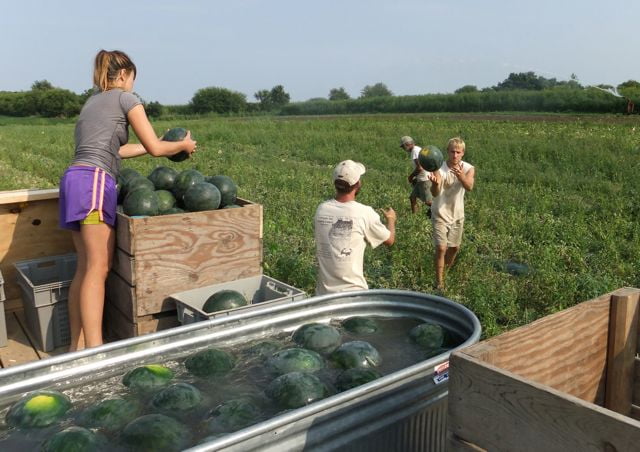
It takes a crowd to harvest watermelons.
Steve (furthest in back) carefully chooses ripe melons. He tosses to David, who tosses to Kyle, who tosses to Brianna on the wagon, who washes the melons. Steve is 65 years old but in great shape. Nonetheless, he’s already asleep because he picked 12,000 lb of melons this week and expects to pick another 4,000 lb tomorrow. You can see white spray from the irrigation gun in the top right corner of the photo above. Steve and the others were at the edge of the irrigation mist during melon harvest, the perfect place to be on a hot day.
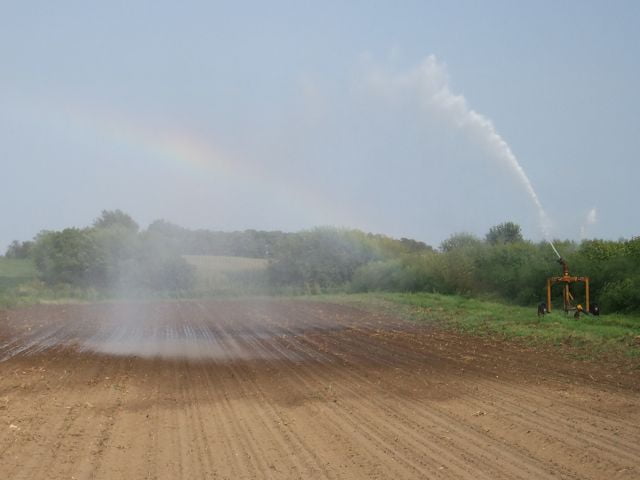
Traveling irrigation gun with rainbow.
We’re back to irrigating all our crops. There’s been little rain for 8 weeks. We coasted for a while on the heavy rains that came in June, then cool weather protected the plants from stress for a few more weeks. At this point our crops will not grow without extra water. We are counting on our strong irrigation well which pulled us through last year’s drought.

Blue and Boi use tip scales to weigh potatoes for the CSA boxes.
Our outdoor packing shed is another good place to be during hot sunny days.
Veggie List and Veggie Notes
1 melon (watermelon OR muskmelon OR crenshaw)
sweet corn, about 5 ears
“new” red potatoes, 3.25 – 3.5 lb
mixed slicing and plum tomatoes, 3 lb
white onion, 1 large
Romano beans, 1.1 lb
red Italian frying peppers, 2 or 3
#2 grade red bell peppers, 0 or 1
green leaf lettuce, 1
parsley, 1 bunch
You will receive 1 or 2 squash if we can fit them in your box.
Next week’s box will probably contain watermelon, tomatoes, peppers, onions, basil and more
Melons – We grow a variety of different melons and will continue to rotate the types among the pick-up sites. Red watermelon are traditional seeded varieties. Yellow watermelons are smaller with very sweet flesh and a softer texture than red watermelons. You know our muskmelons by now – we’ve sent them for several weeks because they’ve been quite tasty. One site (Evansville) will get crenshaw melons this week. These look like muskmelons but have a different flavor.
“New” red potatoes – The potatoes are from Chris Malek of Malek Family Stewardship Farm. They were harvested young enough that the skins have not set but (unlike most new potatoes) they were grown to full size. The skins are fragile so handle carefully while cooking. I boiled a pot until just cooked and they made fabulous potato salad. Chris advises that you refrigerate these potatoes because they lose moisture very readily at this stage. Don’t overcook them.
White onion – We’re sending white onions for a change from Walla Wallas. The white onions are more pungent than Wallas and have low moisture so they will fry, although they do not fry as well as yellow storage onions.
Romano beans – Steve asked me to write that the Romano beans are at full maturity and will hold up to a braising recipe. These are lovely beans, nicer than the batch we sent two weeks ago.
A fresh pair of hands
- On: August 14, 2013
 0
0
We hired a new worker to help Steve with his varied tasks, especially machinery repair and tractor work. Larry comes to us with broad experience, having run his own small business. He wasn’t scared off by our motley used equipment. He and Steve share a sense of humor. Larry bought a $6 set of feeler gauges for fine-tuning engines. Steve took the tool in his hands and said, “These are nice but I don’t know how to use them if they aren’t rusty.” They both cackled for a while. It was a guys-who-fix-things joke.
Steve knows how to do everything. He just can’t get it all done himself so he needs Larry’s help. Of course, all our employees fit that description. We have a long list of projects lined up for Larry.

Steve and Larry have this job under control.
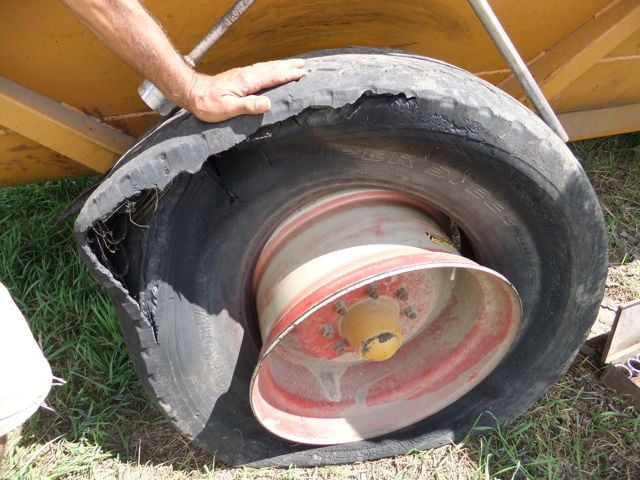
Steve says this tire is currently the worst of the 160 tires we have on our farm.
When Should You Refrigerate Tomatoes?
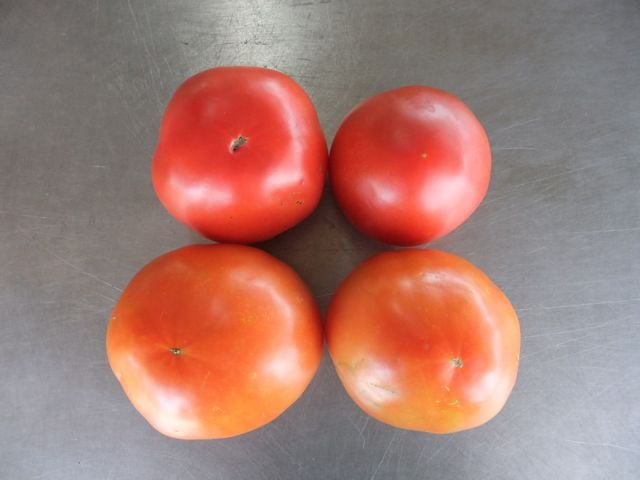
Ripe tomatoes (top) and less-ripe tomatoes (bottom).
As usual, we have packed a mix of ripe and less-ripe tomatoes so you can stretch them through the week. The top two tomatoes in the photo are ready to eat. The bottom tomatoes need to ripen at room temperature for a few days. Put on your counter or keep in a brown paper bag.
Tomatoes retain their best flavor and texture when stored at room temperature, no lower than 55oF. However, you should refrigerate your tomatoes if they are fully ripe and you don’t expect to eat them right away. It is better to sacrifice a little flavor and texture than lose your tomatoes to rot. Also, fully-ripe tomatoes are less sensitive to chilling injury.
#2 Grade Red Bell Peppers
I write about pepper grading every year. Returning members can say “yeah, yeah” and skip ahead. New members, please read.
Many of the red bell peppers we send in the CSA boxes will be our #2 grade. We do this to avoid waste and to deliver good value to our CSA members. The #2 grade peppers are excellent eating quality, but are not quite pretty enough to sell to stores. As a result, we place a much lower value on these peppers. This allows us to provide generous amounts of red bell peppers over the course of the season, about three times the amount we could provide if we only gave #1 grade. We feel this is a good exchange, even if it means you occasionally open a pepper and find that it needs trimming. Here are the reasons that peppers are downgraded from #1 grade to #2 grade:
1. They may have a minor blemish, or
2. They may have minor insect damage, or
3. They may be very ripe and beginning to wrinkle. (These are especially sweet and delicious as they are fully ripe. These cannot be sold to stores because their shelf life is short. You will find that the texture is less crisp than a #1 grade pepper, but the flavor more than makes up for it.)
4. They might be partially red and partially green.
5. Others are just too small.
The eating quality is fine (or excellent) for all these #2 peppers. We throw away all peppers that we suspect have rot inside (although one may occasionally slip through in either #1 or #2 grade.) Today’s peppers are #2 grade.
Veggie List and Veggie Notes
muskmelon, 1
sweet corn, 6 ears
slicing tomatoes, 4 lb
green leaf lettuce
#2 grade bell peppers, 2, red or ivory
Walla Walla onions, 1 or 2
garlic, 1 head
oregano, 1 small bunch
You will get one or two of these items: broccoli OR eggplant OR cucumbers/pickles OR cherry tomatoes
Next week’s box will probably contain melon, tomatoes, peppers, lettuce, sweet corn, onions, parsley and more.
Muskmelon – Don’t worry if you haven’t received a watermelon from us yet. We send more muskmelons at the beginning of melon season while their flavor is at its best.
Garlic – The garlic is from John Hendrickson of Stone Circle Farm. John supplies our garlic bulbs and scapes.
Broccoli – These heads are from a spring planting that drifted away from its usual schedule. That can happen in hot weather. It’s so unexpected to have broccoli in mid-August. The uneven heads are typical of summer broccoli. Steve says you might need to trim a bit, and to watch for green “worms” hidden in the heads. Submerge the broccoli in water, shake, and they will float free. I’m making it sound horrid but it’s actually nice broccoli.
Our hidden beach
- On: July 31, 2013
 0
0
I write often about our farm work, but rarely about the fun of living on a farm. The previous owners of our farm created a sand pit. They sold sand for road construction, leaving an open bowl-shaped pit in a hillside. When we bought our farm, I viewed it as an ugly scar on the landscape and plotted to bulldoze it flat. Wow, I was so wrong. It has become a favorite place for our family. Our children find it endlessly interesting. It was a giant sandbox when they were young, then a terrifyingly steep sled run, now a sheltered and exotic fire pit. For Steve and me, it is a direct look at the glacial till that underlies our farm.
I appreciate the pit on cool fall days. The west-facing slope catches warmth from the setting sun. We picnic there in short-sleeves but would need snow jackets up above. I asked our son what he likes best about the sand pit.
“It’s a good place to find fossils.”
“There’s no dirt – it’s all sand and gravel and there are even different types of sand.”
“It’s a mini desert.”
It is a child’s paradise. We remember the birthday party when a pack of kids soaked themselves under the irrigation, then ran to the sand pit to roll in the warm sand. They looked like sugar doughnuts. This is cheap fun.
Farm News.
• Email brown-out. Remember, I will be away from the farm next week. Please limit communication with us during August 2 through August 12. Contact me no later than 8 a.m. this Friday to cancel a box, ask questions, etc.
• I will deposit post-dated August 1 checks on August 2.
• Carrots. We are working intensively to establish our fall carrot crop. Steve is in the midst of replanting two acres. He planted those fields just before the hot spell and the seeds did not germinate well. This is our last chance to replant. Any later and the carrots will not be ready to harvest before winter sets in. The weeds are growing quickly. Our crew battles them every day. We will be relieved once the new fields are well established. Have you noticed that carrots are missing from the CSA boxes? We often deliver carrots in late July but lost the early planting to weeds during a wet spell in May. Look for carrots from us in about one month.
• The crew’s work is very straightforward right now. It’s all harvesting and weeding. We seeded our last flats of transplants, fall greens like Yukina and mizuna to fill the CSA boxes in November. Those plants will go in the ground in late August, then our greenhouse work is done for the year.
• Spotted wing drosophila (SWD) has appeared in our raspberries again this year. This new fruit fly pest devastated Wisconsin’s fall raspberry crop last year. Once again, it has shown up across the state. Steve has begun weekly applications of organic pesticides. We have recognized the SWD earlier than last year, and are hopeful about limiting the damage. We are optimistic enough that we trellised the brambles this week for easy picking. Our farm is participating in a UW monitoring program to track SWD. Ironically, our children were the first to find the bugs, just like last year. They are observant kids with little fingers, lots of time and a love of raspberries. They spend a lot of time in the berry field.
Veggie List and Veggie Notes
Sweet corn, about 7 ears
Muskmelon, 1
Lacinato OR green kale, 1 bunch
Green bell pepper, 1 or 2
Walla Walla onions, 1 or 2
Zucchini or summer squash, 2 squash
Cucumbers, 2
Slicing tomatoes, about 1 lb
Cherry tomatoes OR eggplant OR green beans
Next week’s box will probably contain watermelon, tomatoes, cabbage, peppers, onions, Romano beans and more.
Sweet corn – Be prepared: some tips will need trimming. Otherwise, this is an excellent, tasty batch of corn.

